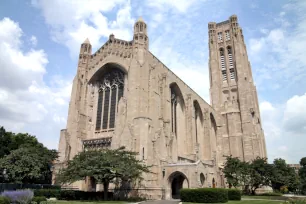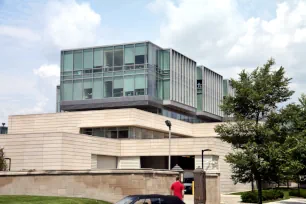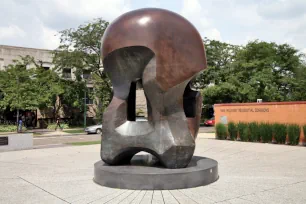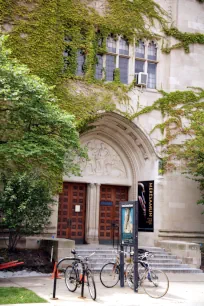Located on Chicago’s South Side, the campus of the University of Chicago is an architectural delight, with both historic neo-Gothic and modern buildings. There are also some interesting museums on site.


Founded in 1891 with a donation from John D. Rockefeller, the University of Chicago is an excellent academic institution that has had so many Nobel laureates that it is sometimes referred to as ‘Nobel Alley’. Strolling around the campus is a real treat thanks to the many interesting buildings created by numerous notable architects including Henry Cobb, Mies van der Rohe and Eero Saarinen.
The Architects
The original plans for the university were drawn up by architect Henry Ives Cobb. Cobb was already renowned for his designs, and modeled his buildings for the university after the Gothic style treasures on the Oxford campus in England. Not all the buildings were designed by Cobb, but some of the most memorable are his, including Cobb Hall, which is the oldest building on campus. It’s a magnificent Gothic structure that houses small classrooms, offices, and – currently – a contemporary art gallery. Other Cobb-built buildings on the Main Quadrangle include the Ryerson Physical Laboratory and the Kent Chemical Laboratory, both built in 1894.
After the turn of the twentieth century, the design firm of Shepley, Rutan & Coolidge was appointed campus architect. They were famous for their design of the Art Institute of Chicago and didn’t disappoint at the University. Their masterpieces include the William Rainey Harper Memorial Library, the Hutchinson Court and Tower group of buildings, and the Bartlett Gymnasium. After those buildings were constructed, no particular firm was hired, but rather, various notable architects were selected for projects.
The Architecture
Rockefeller Memorial Chapel




For many years, however, the Gothic design was maintained. One of the prime examples of that is the most noticeable structure on the campus, the Rockefeller Memorial Chapel. This amazing ecclesiastic building was designed by Bertram G. Goodhue in the 1920s and contains stained-glass windows, a 10,000-pipe organ, a 72-bell carillon, and a number of excellent works of art.
Main Quadrangle
The heart of the University of Chicago is the Main Quadrangle, which lies just northwest of the Rockefeller Memorial Chapel. Neo-Gothic architecture dominates here as well, with the aforementioned Cobb Hall and the ivy-covered Bond Chapel – with beautiful stained-glass windows illustrating scenes from the New Testament – as the most notable structures. A neo-Gothic archway, known as the Cobb Gate, marks the northern entrance to the main Quadrangle. The gate, decorated with gargoyles, was donated by Cobb to the university in 1900.
Modern Architecture
After World War II, the face of the campus of the University of Chicago began to change, and modern structures emerged under the direction of famed architect Eero Saarinen. The first were part of Saarinen’s Law School complex – with a glass clad library building at the center of a reflecting pool, built in 1959 – and Mies van der Rohe’s Social Services Administrative Building (1965). Also of note is the limestone-built Regenstein Library, the university’s main library, completed in 1970.
In the 1990s, the university once again examined the campus and decided that, in the next few decades, at least a dozen new buildings would be essential to the campus. Worth a look are the Graduate School of Business, designed by Raphael Vinoly; the colorful Palevsky Commons and the University of Chicago Press Building, a rather traditional masonry structure newly built in 2000 to house the growing university press, one of America’s premiere university-related press operations. The most eye-catching of the new additions is the Joe and Rika Mansueto Library, a modern glass-domed expansion of the Regenstein Library, which opened in May 2011. The entire book collection is underground; robot cranes retrieve books on demand.
Nuclear Energy

Just north of the Joe and Rika Matsueto Library is a small plaza with a central bronze sculpture entitled ‘Nuclear Energy’. The mushroom-shaped monument, designed by Henry Moore, commemorates the first self-sustaining controlled nuclear chain reaction in 1942, achieved by a team of physicists at the University of Chicago.

Museums
The Smart Museum of Art was established in 1974 with donations from David and Alfred Smart, founders of the Esquire magazine. The museum has a mixed collection with historic Asian and European artwork as well as modern and contemporary art.
The museum also displays modern design, including authentic furniture from Frank Lloyd Wright’s Robie House, which is located nearby and is now owned by the university.
The Oriental Institute is both a research institute and a museum with an impressive collection of artifacts from the Near East and Egypt, excavated by the university’s scholars. Some of the highlights include a fragment of the Dead Sea Scrolls, a colossal statue of King Tutankhamun and the oldest known tin bronze figurines in the world, dated 3000 BC.
Not on the campus proper, but within walking distance is the DuSable Museum of African History, America’s oldest institution devoted to African art and heritage. The museum not only displays traditional African art, but it also documents the history of African Americans in the U.S.

